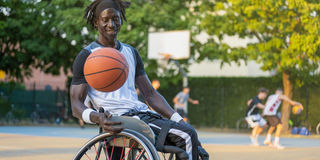Prime
The benefits of adaptive sports activities

Look at what you can do in your current condition and improve your abilities. PHOTO | istock
Exercising and participating in sports should be enjoyed by all people irrespective of their physical abilities.
Additionally, health and fitness recommendations state that an adult should get a minimum of 150 minutes of exercise every week for moderately intensive workouts. Alternatively, one should do 75 minutes of high intensity workouts. However, this is not possible if one has an ability impairing injury or disease. Even aging could work against a previously active person.
That is why adaptive sports is an amazing idea in the health and fitness arena.
According to msktc.org, adaptive sports allow for modification of typical sports activities to allow people of different disabilities exercise. These sports use a classification system that categorises people with physical challenges in order to find a sport fit for them; putting them on an even ground with other people.
For instance, according to paralympic.org, there are 10 eligible impairment types in Para Athletics; eight physical impairments as well as vision impairment and intellectual impairment.
These are classified as T11-13 (vision impairment), T20 (Intellectual impairment), T35-38 (Co-ordination impairments (hypertonia, ataxia and athetosis)), T40-41 (Short stature), T42-44 (Lower limb competing without prosthesis affected by limb deficiency, leg length difference, impaired muscle power or impaired passive range of movement). There is also T45-47 (Upper limb/s affected by limb deficiency, impaired muscle power or impaired passive range of movement) and T61-64 (Lower limb/s competing with prosthesis affected by limb deficiency and leg length difference).
T is for track, while the number, say 37 shows the sport among field events, three is cerebral palsy while seven shows that the athlete has weakness or spasticisty on one side of the body.
Msktc.org states that this detailed classification system allows for fair competition among the different participants.
However, Jackie Kisame, a fitness trainer, says classification is not enough if people with disability are to have their confidence boosted as well as enjoy fair play on the field.
"There are several mechanisms that must be added to, say the training track to help these people. For example, a visually impaired athlete will need the starting point of the running track well marked with chalk. If possible, having a running guide will help them run better," she says.
Work on your strengths
With disabilities, there are things you cannot ably do. Therefore, Kisame says, there is no need to pressurise yourself.
"Do not focus on what you cannot do. For instance, if your leg has been amputated, there is no need to try and run as though you had both limbs. Or, if you lose one hand, you do not have to bother about you inability to participate in netball as you did before. The focus is on ensuring you remain active. Therefore, look at what you can do in your current condition and improve your abilities," she says.
Become part of a group
Seeing that people with disabilities usually work in groups, even access to services as well as activities is done through the same. Therefore, Kisame advises, people with disabilities to become part of a group.
"These groups do not only offer you a place to work out from but are also helpful in giving support in times where one feels unable to cope. Working in a group also means sharing knowledge to help people grow," she says.





